12 December 2011
Koji Suzuki, Faculty of Environmental Earth Science, Hokkaido University
We carried out the KT-12-31 cruise of the R/V Tansei Maru (Photo 1) for “Understanding the biogeochemical processes and lower trophic structure in the Kuroshio region south of Kyushu”, as part of the SKED project and a cooperation with the Atmospheric and Ocean Research Institute, the University of Tokyo. The participants (Photo 2) were Hiroaki Saito (FRA), Yuji Okazaki (FRA), Yu Umezawa (Nagasaki Univ.), Akira Yamaguchi (Nagasaki, Univ.), Hongbin Liu (HKUST/Hokkaido Univ.), Shun Yan Cheung (HKUST), Takafumi Hirata (Hokkaido Univ.), Koji Sugie (Hokkaido Univ.), Masanori Enoki (MWJ), and Koji Suzuki (Hokkaido Univ.).
As the initial plan, the observation was planned for the KT Line between Cape Toi, Miyazaki Prefecture and Cape Kasarisaki, Amami Island, Kagoshima Prefecture. However, that needed to be changed due to a fishery negotiation. As a result, we set 6 stations in the area located west of Tokara Islands (Fig. 1), and Kagoshima Port was used for the departure and arrival.
The main research purposes were to understand the similarities and dissimilarities of 1) the distributions of macronutrients with nano-molar levels and dissolved organic nitrogen and phosphorous, 2) abundance, composition and productivity of archaea, eubacteria, phytoplankton, microzooplankton, mesozooplankton and small fishes, and 3) underwater optical properties among the inside, center and outside the Kuroshio flowing south of Kyushu. Therefore, we deployed a CTD system with X-Niskin bottles (Photo 3) , VMPS (Photo 4), MOHT (Photos 5 and 7) and neuston net (Photo 6). On-deck bottle incubation experiments were also made. Atmospheric and underwater light measurements using spectroradiometer, spectrophotometer (Photo 9) or scatterometer were also conducted. During the cruise, we also continuously monitored the macronutrients (nitrate plus nitrite and phosphate; Photo 10) and algal photostosynthetic competence (Photo 11) using the seawater collected from an intake (ca. 5 m) of the vessel. Consequently, we found geographical gradients of these parameters from Kyushu to the open ocean. At present, we are analyzing the samples collected during the cruise using state-of-the-art technologies such as elemental isotope analyses using high-precise, high-sensitive mass spectrometers and DNA analyses with the next generation sequencers.

<Fig. 1>
Sampling stations (blue dots) and a schematic flow of the Kuroshio (orange arrow) during the KT-12-31 cruise.
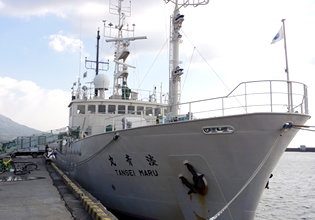 |
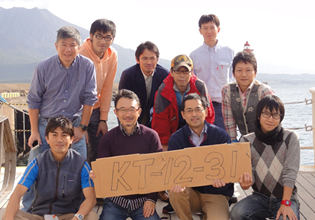 |
|
<Photo 1> The R/V Tansei Maru (JAMSTEC) in Kagoshima Port. |
<Photo 2> A memorial picture taken after the cruise, with Sakura Island for the background. |
 |
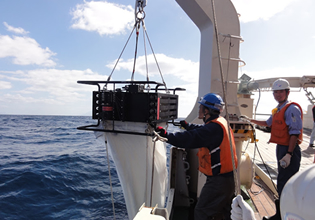 |
|
<Photo 3> A CTD observation. Seawater and in situ data such as temperature, salinity and in vivo chlorophyll fluorescence were collected using the system. |
<Photo 4> Zooplankton sampling with VMPS. |
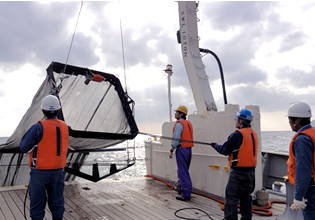 |
 |
|
<Photo 5> Small fish sampling using MOHT. |
<Photo 6> Collecting microorganisms at the sea surface with a neuston net. |
 |
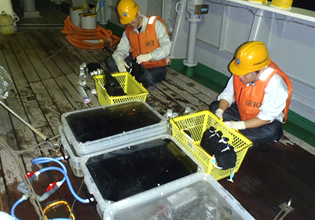 |
|
<Photo 7> Small fishes and miscellaneous organisms collected at Station 3 located in the center of the Kuroshio at night. |
<Photo 8> Preparation for a bottle incubation experiment with tanks. |
 |
 |
|
<Photo 9> Underwater optical measurement using an in situ spectrophotometer. |
<Photo 10> A system for measuring macronutrients in seawater with nano-molar levels. |
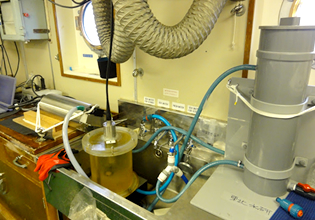 |
||
<Photo 11> An underway FRRF system for monitoring the photosynthetic competence of phytoplankton. |






